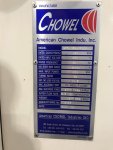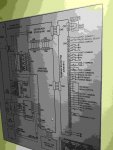Greetings all
Does a spot welder meet the 'specific operation' criteria under 630.31(A)(2)?
I am doing a spot welder branch circuit calc as per [2020 NEC] 630.31 and OCPD sizing per 630.32.
The welder will only occasionally be used. Looking over the example duty cycle in the FPN I can't imagine the duty cycle to be more than 2%.
Its for a 20 year old single spot welder 480V, the company that made the welder is no longer in operation in the US, the only website I can find is in Korean:
The name plate did not give the primary kVA, but it gives the 50% duty cycle as 150 kVA
Model is APR-150A-R12PF
Manufacturer is Americian Chowell

I believe its a single phase 480V connection.
The 'Max Input Power' of 858 kVA seems way off, ignoring that I am extrapolating the kVA by:
Reversing the 50% duty cycle on the nameplate: 1/.71 = 1.4
kVA = 150 X 1.4 = 211
T630.31(A) value is .22 for 5% or less
So 211 X .22 = 46.42 kVA
or minimum supply conductor = 97 Amps at 480V
If I stick to the 50% duty cycle I'd be at 312 Amp conductor size, which seems way off.
If I am wrong and the welder has a 3 phase primary it would be at 175 Amps which is within reason but still seems extreme.

Does a spot welder meet the 'specific operation' criteria under 630.31(A)(2)?
I am doing a spot welder branch circuit calc as per [2020 NEC] 630.31 and OCPD sizing per 630.32.
The welder will only occasionally be used. Looking over the example duty cycle in the FPN I can't imagine the duty cycle to be more than 2%.
Its for a 20 year old single spot welder 480V, the company that made the welder is no longer in operation in the US, the only website I can find is in Korean:
The name plate did not give the primary kVA, but it gives the 50% duty cycle as 150 kVA
Model is APR-150A-R12PF
Manufacturer is Americian Chowell

I believe its a single phase 480V connection.
The 'Max Input Power' of 858 kVA seems way off, ignoring that I am extrapolating the kVA by:
Reversing the 50% duty cycle on the nameplate: 1/.71 = 1.4
kVA = 150 X 1.4 = 211
T630.31(A) value is .22 for 5% or less
So 211 X .22 = 46.42 kVA
or minimum supply conductor = 97 Amps at 480V
If I stick to the 50% duty cycle I'd be at 312 Amp conductor size, which seems way off.
If I am wrong and the welder has a 3 phase primary it would be at 175 Amps which is within reason but still seems extreme.


